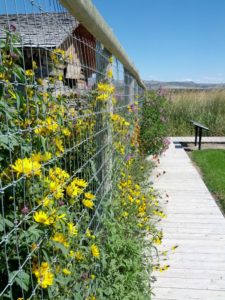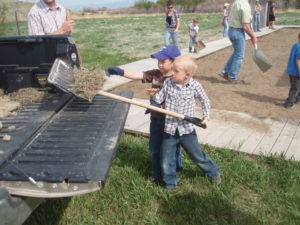Getting Kids Involved with Pollinators

Due to numerous factors, pollinators, which include more than just bees, are experiencing severe population declines across the United States. Because of the vital role that these species play in the reproduction of many plants, it has being addressed as a concerning issue. Many organizations government and nongovernment alike are advocating the planting of pollinator friendly plants to aid in creating habitat for pollinating species. A plant that is considered pollinator friendly is a plant that requires an organism (pollinator) to transport pollen between different individuals to successfully reproduce.
The Ruby Habitat Foundation is a strong advocate of pollinator projects. Recently the foundation teamed up with the local Sheridan school district to help create pollinator habitats for the foundations latest project.
Miss Konopacki’s kindergarten class learned about pollination and the important role that pollinators play in the environment. They also learned about the different kinds of bee’s that are native to Montana and where some of those species prefer to nest. After a brief education about the different kinds of bee nests, the kids were joined by Mrs. Bank’s Advanced Biology class to construct and paint some bee habitats. The habitats were constructed out of wood and clay in an attempt to target several different native species nesting areas with hopes of finding numerous guests this summer.
As the season progresses and spring emerges the kids from both classes will be taking a field trip out to the foundation to help set up the pollinator habitats on the ranch. The will also spend some time in the field learning more about the vital role that pollinators play.
The Ruby Habitat Foundation is teaching by example in showing how it is possible to have a successful agriculture enterprise while maintaining pristine natural resources and enhancing specific habitats to allow for niche animals such as pollinators to flourish.

Growing Pollenizers for the Sake of Pollinators
A pollinator is the biotic agent that moves pollen from the male anthers of a flower to the female stigma of a flower to accomplish fertilization or ‘syngamy’ of the female gametes in the ovule of the flower by the male gametes from the pollen grain. A pollinator is different from a pollenizer, which is a plant that is a source of pollen for the pollination process. http://en.wikipedia.org/wiki/Pollinator
Almost everyone, if given the knowledge and opportunity, quickly comes to appreciate the beauty and wonder of the natural world. Regardless of season, location or circumstance, we hold the earth and its inhabitants in high regard. Over the years, the Ruby Habitat Foundation has made an effort to restore native plant communities on the Woodson Ranch. Increasingly we have begun to work with a variety of native and introduced flowering shrubs and forbs for a number of reasons:
- Pollinators visit flowers in search of food, mates, shelter and nest-building materials. The energy that powers pollinator growth, metamorphosis, flight and reproduction comes from sugars in nectar, and the proteins, fats, vitamins and minerals from pollen grains.
- Due to numerous factors, all pollinators, not just bees, are experiencing severe population declines across the United States. Pollinator species play a vital role in the production and the reproduction of many plants. The Ruby Habitat Foundation joins the many governmental and nongovernmental organizations that are advocating the establishment of pollinator friendly plant communities (pollenizers) to aid in habitat creation for pollinating species.
- Most plants require the assistance of pollinators to produce seeds and fruit. About 80% of all flowering plants and over three-quarters of the staple crop plants that feed humankind rely on pollinators.
- More than 3,500 species of native bees help increase crop yields. Some scientists estimate that one out of every three bites of food we eat exists because of animal pollinators like bees, butterflies and moths, birds and bats, and beetles and other insects. – See more at: http://www.nrcs.usda.gov/wps/portal/nrcs/main/national/plantsanimals/pollinate/#sthash.
- The incredible bond of the partnership is that neither the polleinizer nor the pollinator can exist in isolation – one relies upon the other.
